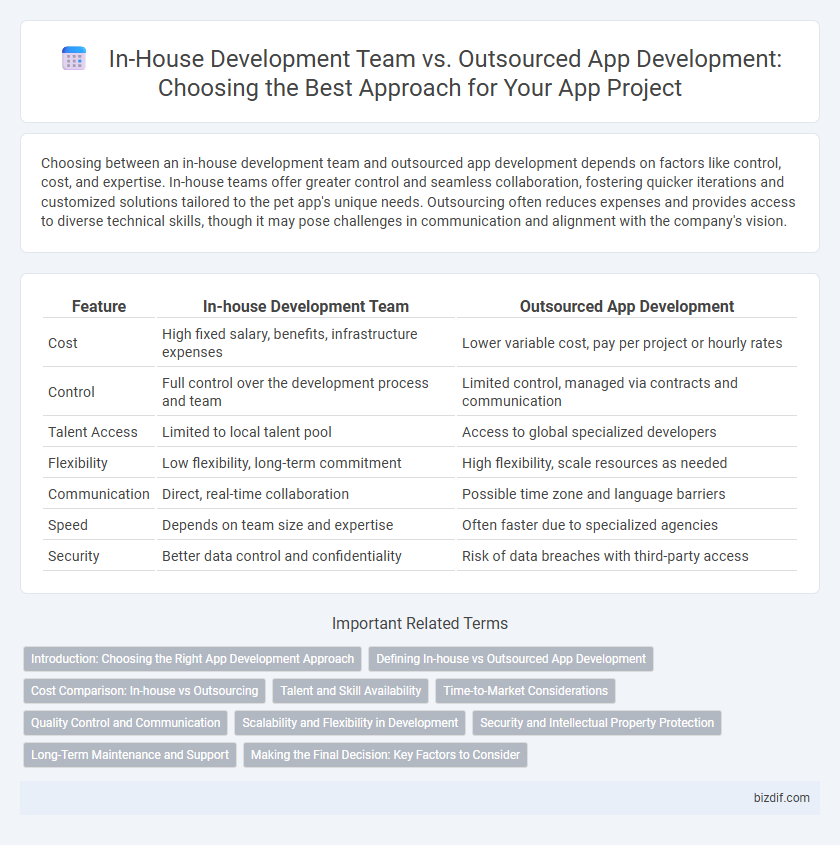Choosing between an in-house development team and outsourced app development depends on factors like control, cost, and expertise. In-house teams offer greater control and seamless collaboration, fostering quicker iterations and customized solutions tailored to the pet app's unique needs. Outsourcing often reduces expenses and provides access to diverse technical skills, though it may pose challenges in communication and alignment with the company's vision.
Table of Comparison
| Feature | In-house Development Team | Outsourced App Development |
|---|---|---|
| Cost | High fixed salary, benefits, infrastructure expenses | Lower variable cost, pay per project or hourly rates |
| Control | Full control over the development process and team | Limited control, managed via contracts and communication |
| Talent Access | Limited to local talent pool | Access to global specialized developers |
| Flexibility | Low flexibility, long-term commitment | High flexibility, scale resources as needed |
| Communication | Direct, real-time collaboration | Possible time zone and language barriers |
| Speed | Depends on team size and expertise | Often faster due to specialized agencies |
| Security | Better data control and confidentiality | Risk of data breaches with third-party access |
Introduction: Choosing the Right App Development Approach
Selecting between an in-house development team and outsourced app development hinges on factors such as budget, project complexity, and desired control over the process. In-house teams offer direct communication and tailored expertise but may incur higher operational costs and longer ramp-up times. Outsourcing provides access to a broader talent pool and faster scalability, often reducing expenses while requiring robust project management to maintain quality and deadlines.
Defining In-house vs Outsourced App Development
In-house app development refers to building software applications using a team of developers employed directly by the organization, ensuring full control over the project and seamless collaboration. Outsourced app development involves hiring external service providers or agencies to design, develop, and maintain applications, often leveraging specialized expertise and cost efficiencies. Defining these approaches highlights key factors such as team integration, communication dynamics, intellectual property management, and budget allocation in app project execution.
Cost Comparison: In-house vs Outsourcing
In-house development teams often incur higher fixed costs due to salaries, benefits, office space, and training, making them more expensive upfront compared to outsourcing. Outsourced app development offers flexible pricing models such as fixed-price, time and materials, or dedicated teams, which can significantly reduce operational expenses and scale costs based on project needs. However, hidden costs like communication overhead, project management, and quality assurance should be factored into the total cost of outsourcing to ensure an accurate comparison.
Talent and Skill Availability
In-house development teams offer direct access to specialized talent with deep company knowledge, ensuring precise alignment with project goals and immediate collaboration. Outsourced app development provides access to a broader talent pool, often including niche experts and cost-effective resources from various geographic locations. Talent availability in outsourcing can speed up project timelines but may require additional management to align skills with specific app development requirements.
Time-to-Market Considerations
In-house development teams offer greater control and faster communication, which can streamline iteration cycles and reduce time-to-market for app projects. Outsourced app development can leverage specialized expertise and scalability but often involves longer onboarding and coordination phases, potentially delaying delivery. Choosing between the two depends on project complexity, required speed, and resource availability to optimize product launch timelines.
Quality Control and Communication
In-house development teams provide direct oversight, ensuring stringent quality control through continuous monitoring and immediate feedback during the app development process. Outsourced app development can face communication delays and challenges, potentially impacting the consistency and precision of quality assurance. Effective communication channels and clear project management tools are essential to maintaining high standards and timely iterations regardless of the development model.
Scalability and Flexibility in Development
In-house development teams offer greater control over scalability and flexibility, allowing seamless communication and immediate adjustments to project requirements. Outsourced app development provides scalable resources that can be adjusted based on demand but may face challenges in flexibility due to time zone differences and communication barriers. Choosing between the two depends on the company's need for dynamic adaptation versus resource scalability in app development projects.
Security and Intellectual Property Protection
In-house development teams provide enhanced security controls, as companies retain full oversight of sensitive data and proprietary code during the app creation process. Outsourced app development may introduce risks related to intellectual property theft or data breaches due to third-party access and varied security standards across vendors. Choosing an in-house team often ensures stronger intellectual property protection and compliance with company-specific security protocols.
Long-Term Maintenance and Support
An in-house development team offers direct control over ongoing app maintenance and faster issue resolution due to closer collaboration and deeper product understanding. Outsourced app development can reduce initial costs but may face challenges in consistent long-term support and slower response times caused by communication barriers and external dependencies. Choosing in-house teams typically ensures a stronger alignment with evolving business goals and smoother implementation of updates and customizations.
Making the Final Decision: Key Factors to Consider
Choosing between an in-house development team and outsourced app development hinges on factors such as budget constraints, project complexity, and timeline requirements. In-house teams offer greater control and easier communication, while outsourcing provides access to specialized skills and scalable resources. Evaluating intellectual property security, team expertise, and long-term maintenance needs ensures alignment with business objectives and app success.
In-house Development Team vs Outsourced App Development Infographic

 bizdif.com
bizdif.com